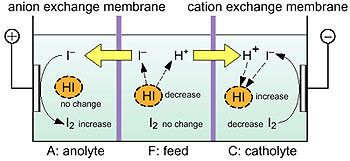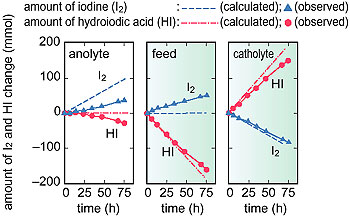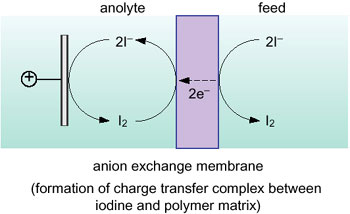Research of a thermochemical process, the IS process, which produces hydrogen from water, is being advanced with the aim of realizing clean hydrogen-based energy systems. In this process, water reacts with iodine (I2) and a sulfur compound (SO2), forming hydrogen iodide HI. Hydrogen is then generated by thermal decomposition of HI. In the IS process, hydrogen iodide must be separated efficiently from the mixed solution (HI-I2-H2O solution: 10 mol-HI/kg-H2O) of highly concentrated iodine and hydroiodic acid. Since this solution has a quasi-azeotropic composition, separation by distillation is impractical. Considering the ionicity of the solution, we searched for other separation methods, and observed that electrodialysis is widely utilized in industrial processes for separating salts, such as desalination of sea water.
The electrodialysis of hydroiodic acid that dissolved iodine was studied using the apparatus shown in Fig. 2-8. Iodide ions (I- ) and hydrogen ions (H+), driven by the electric potential differences between the electrodes, migrate toward the anode and cathode, respectively. Consequently, it was expected that hydroiodic acid would be separated and concentrated (Fig. 2-9, calculated value). In the electrodialysis experiments, hydroiodic acid was concentrated in the catholyte as expected. In contrast, however, an unexpected phenomenon was found with respect to the anion exchange membrane; the neutral iodine molecules I2 were apparently transported against the concentration gradient through the membrane (Fig. 2-9, measured value). This new phenomenon can be explained if the electron conductivity in the membrane were endowed with a charge transfer interaction between the iodine and polymer matrix, which constitutes a membrane (Fig. 2-10).
This phenomenon is similar to up-hill transport, movement of solute to the high concentration solution side from the low concentration side, that occurs through a membrane. This phenomenon is viewed with interest in membrane chemistry. |



